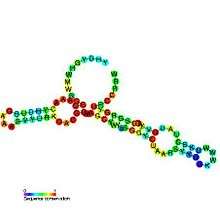Cyclic di-GMP-I riboswitch
| GEMM cis-regulatory element | |
|---|---|
 | |
| Predicted secondary structure and sequence conservation of GEMM_RNA_motif | |
| Identifiers | |
| Symbol | GEMM_RNA_motif |
| Rfam | RF01051 |
| Other data | |
| RNA type | Cis-reg |
| Domain(s) | Bacteria; Viruses |
| SO | 0005836 |
Cyclic di-GMP-I riboswitches are a class of riboswitch that specifically bind cyclic di-GMP,[1] which is a second messenger that is used in a variety of microbial processes including virulence, motility and biofilm formation. Cyclic di-GMP-I riboswitches were originally identified by bioinformatics as a conserved RNA-like structure called the "GEMM motif".[2] These riboswitches are present in a wide variety of bacteria, and are most common in Clostridia and certain varieties of Proteobacteria. The riboswitches are present in pathogens such as Clostridium difficile, Vibrio cholerae (which causes cholera) and Bacillus anthracis (which causes anthrax). Geobacter uraniumreducens is predicted to have 30 instances of this riboswitch in its genome. A bacteriophage that infects C. difficile is predicted to carry a cyclic di-GMP-I riboswitch, which it might use to detect and exploit the physiological state of bacteria that it infects.
The discovery of this riboswitch class answers the question of how genes are regulated in response to cyclic di-GMP levels in many different bacteria. However, some bacteria in which cyclic di-GMP has been studied lack cyclic di-GMP-I riboswitches, e.g. Pseudomonas aeruginosa. Cyclic di-GMP-I riboswitches are the first kind of riboswitch to be discovered whose role is not primarily in regulating metabolism, but is instead part of signaling. A second class of riboswitch that binds cyclic di-GMP is called the cyclic di-GMP-II riboswitch. The two classes of cyclic di-GMP-binding riboswitches do not share any known sequence or structural features.
High-resolution three-dimensional structures of cyclic di-GMP-I riboswitches have been determined using X-ray crystallography.[3][4]
Some homologs of the c-di-GMP-I riboswitch structure actually function a riboswitches that recognize another signaling molecule, cyclic AMP-GMP.[5][6]
References
- ↑ Sudarsan N, Lee ER, Weinberg Z, Moy RH, Kim JN, Link KH, Breaker RR (2008). "Riboswitches in eubacteria sense the second messenger cyclic di-GMP". Science. 321 (5887): 411–3. doi:10.1126/science.1159519. PMID 18635805.
- ↑ Weinberg Z, Barrick JE, Yao Z, et al. (2007). "Identification of 22 candidate structured RNAs in bacteria using the CMfinder comparative genomics pipeline". Nucleic Acids Res. 35 (14): 4809–19. doi:10.1093/nar/gkm487. PMC 1950547
 . PMID 17621584.
. PMID 17621584. - ↑ Kulshina N, Baird NJ, Ferré-D'Amaré AR (December 2009). "Recognition of the bacterial second messenger cyclic diguanylate by its cognate riboswitch". Nat. Struct. Mol. Biol. 16 (12): 1212–7. doi:10.1038/nsmb.1701. PMC 2925111
 . PMID 19898478.
. PMID 19898478. - ↑ Smith KD, Lipchock SV, Ames TD, Wang J, Breaker RR, Strobel SA (December 2009). "Structural basis of ligand binding by a c-di-GMP riboswitch". Nat. Struct. Mol. Biol. 16 (12): 1218–23. doi:10.1038/nsmb.1702. PMC 2850612
 . PMID 19898477.
. PMID 19898477. - ↑ Nelson JW, Sudarsan N, Phillips GE, Stav S, Lünse CE, McCown PJ, Breaker RR (2015). "Control of bacterial exoelectrogenesis by c-AMP-GMP". Proc. Natl. Acad. Sci. U.S.A. 112 (17): 5389–94. doi:10.1073/pnas.1419264112. PMC 4418907
 . PMID 25848023.
. PMID 25848023. - ↑ Kellenberger CA, Wilson SC, Hickey SF, Gonzalez TL, Su Y, Hallberg ZF, Brewer TF, Iavarone AT, Carlson HK, Hsieh YF, Hammond MC (2015). "GEMM-I riboswitches from Geobacter sense the bacterial second messenger cyclic AMP-GMP". Proc. Natl. Acad. Sci. U.S.A. 112 (17): 5383–8. doi:10.1073/pnas.1419328112. PMC 4418906
 . PMID 25848022.
. PMID 25848022.